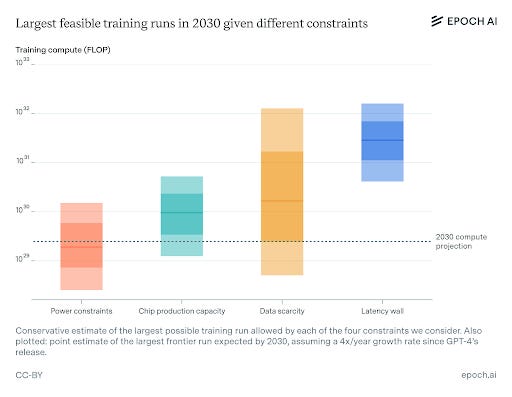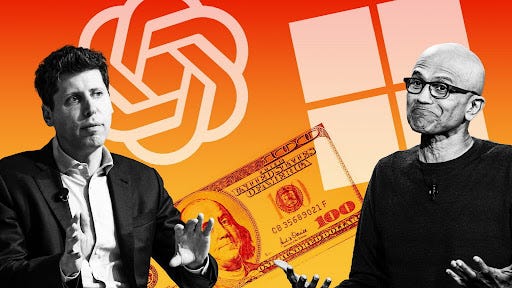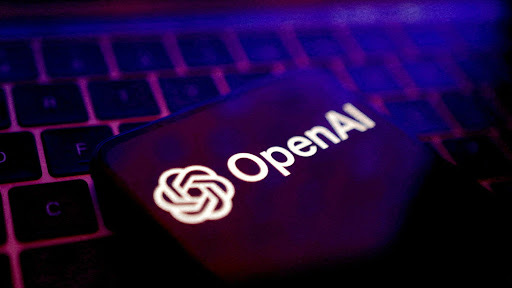Hat Tip to this week’s creators:
Contents
Editorial: There Are No Oligarchs
Essays of the Week
AI
Predictions for AI and Robotics: Big Changes Ahead in the Next 5 Years
Meta to Increase Spending to $65 Billion This Year in A.I. Push
OpenAI struggles to price Microsoft stake in deal to become for-profit company
Stargate artificial intelligence project to exclusively serve OpenAI
Elon Musk Casts Doubt on Trump’s $100 Billion Stargate A.I. Announcement
Tech
Venture Capital
Interview of the Week
Andrew Keen and Esther Dyson
Startup of the Week
Post of the Week
AI will change the social contract
Editorial: There Are No Oligarchs
We should all be amazed and happy that highly competitive technology leaders sat on the same stage at Trump’s inaugauration. There has probably never been an inauguration like it. These are the world’s most valuable companies, coming together, to celebrate innovation, and seeking to influence a US Government, to help make the future happen.
So far it seems to be working. Leaving aside all of the objectionable elements of Trump, he seriously seems to be a champion of growth and innovation across AI, Crypto, Space and much besides.
We are not looking at an oligarchy, but at a business mission with the right people in the room.
There’s no question that artificial intelligence has taken center stage this week, though. The inauguration ran it a close second.
Mark Zuckerberg underscores Meta’s colossal spending plans in a TechCrunch piece, stating, “We’re committing more than ever to our AI infrastructure—1.3 million GPUs is just the beginning.”
According to a Reuters report, he also emphasized, “We expect to invest up to $65 billion in capital expenditure this year to power our AI goals.”
This commitment echoes across other players in the industry. OpenAI’s newly introduced “Operator” service (via TechJuice) is described as an “effortless task-handling” solution that could enable vast improvements in productivity for everyone from solo entrepreneurs to large corporations. Meanwhile, the Financial Times reveals a complex dance around how to price Microsoft’s stake in OpenAI: “Valuations in the AI sector are moving so quickly that today’s number can be outdated tomorrow,” one investor said, highlighting the current sense of urgency—and opportunity.
The AI boom has an obvious political dimension. In the New York Times coverage of Elon Musk’s doubts about Trump’s $100 billion Stargate A.I. announcement, Musk is quoted as saying, “Big numbers are good headlines, but real AI leadership requires sustainable development and clear goals.”
In doing so he was sending a silent ‘FU’ message to Sam Altman who seems to be the biggest beneficiary of Stargate - the $500 billion data center announced by Trump, Altman, Oracle, Masayoshi San and Microsoft among others.
The fact that Musk, Zuckerberg and Altman are fighting over what the future looks like. And that Musk would make fun of a $500 billion project announced by Trump, are signs that the so called Oligarchy is actually not.
They are businessmen seeking favor in Trump, all with their own goals, often conflicting.
In terms of importance this claim of Oligarchy is a mere sideshow compared to the substantial investments in AI. Moreover, the claim of oligarchy lacks credibility.
The concept has been invoked by President Biden and embraced by ideologues who lack critical thinking skills. Why would you not want the leading innovation companies in Washington, D.C.? And why would you not want them to make a positive impact (or, in the words of the ideologues, wield power)?
This week we saw DeepSeek, a Chinese AI model, jump to the front of AI attention. It used reinforcement learning to train a model very cheaply that can compete with the best models. Then they released it to open source.
In the same week OpenAI announced ‘Operator’ an AI agent approach that can use a browser to perform many manual tasks by being prompted.
Rohit Krishnan’s essay - What would a world with AGI look like? - looks at the implications of AGI for society, as does this week’s post of the week by Sam Altman.
"His post on X stated that AI will force a reconsideration of the social contract. His point is that there is going to be progress and it will have implications. We need to talk about that.
Trump and David Sacks are also opening up the US to crypto. A Davos headline from Trustnodes reads, “Bitcoin Will Surpass Gold Reserves Says Brian Armstrong.” Whether or not such predictions prove correct, it’s emblematic of a broader optimism about how decentralized finance might grow. Andreessen Horowitz, as covered by Coingape, is still betting big on U.S. crypto markets, with one partner remarking, “We see relentless innovation in American crypto startups, even amid regulation uncertainty.”
Venture Capital: Shifting Gears, Finding Growth
Venture capital dynamics are also in flux. Larger seed rounds are not only surviving this market climate but sometimes thriving, as noted by Crunchbase: “Seed Rounds Got Larger Through The Downturn. Why Is That?” The answer lies in the faith investors place in disruptive technologies—particularly AI and robotics. Even though some sectors like food and cannabis are seeing funding drop, “robotics and AI remain bright spots for those with a stomach for risk and a vision for the future,” another Crunchbase article suggests.
At the same time, Andreessen Horowitz is pulling back from UK crypto projects, per the Financial Times, reflecting how rapidly shifting regulatory environments can create uneven global investment maps. But even this is reason for guarded optimism: as certain markets mature, capital flows to the places best equipped to nurture the next wave of breakthroughs.
Pro-Innovation Outlook
Rather than dwell on a mythological emerging Oligarchy, or the potential pitfalls of regulatory tussles, competitive pressures, or occasional missteps—I have an optimism-first approach.
If even a fraction of the advanced AI capabilities, decentralized finance projects, and next-generation robotics now being funded reach widespread adoption, the world will look very different. As Jowyang’s Beehiiv newsletter frames it, “We’re on the cusp of AI agents revolutionizing knowledge work, personal productivity, and even creative pursuits.”
Innovation at scale is rarely a smooth ride, but the collective energy is staggering—and encouraging. Each step forward, from new GPU deployments at Meta to specialized AI agents managing everyday tasks, expands what humans can achieve. The winners, in a grand sense, are all of us, as tools become more powerful, customization becomes more accessible, and entire new industries take shape.
Yes, there will be challenges—data privacy, algorithmic fairness, and the ethics of automated decision-making among them. But these challenges also create fertile ground for the next wave of problem-solvers. A robust community of researchers, entrepreneurs, and policymakers, all engaged in harnessing AI for social good, can steer us toward solutions that are both profitable and beneficial.
From massive data-center investments to the explosion of specialized AI startups, the story of this week’s headlines is one of rapid transformation. Venture capital is adapting, tech giants are spending, and brand-new AI agent services promise to upend what we thought was possible. Rather than fear these changes, we can channel them into positive momentum—building a future that is richer, more efficient, and surprisingly more human as technologies take on rote tasks and free us for deeper work and creativity.
As the author of one of this week’s AI articles put it, “Innovation isn’t a luxury—it’s the fuel that drives human progress forward.” Despite the hype, there’s genuine excitement here grounded in real-world results. And that, in itself, should give us reason to be optimistic about what comes next.
Essays of the Week
What would a world with AGI look like?
Source: Strange Loop Canon | Published: 2025-01-22 | Reading Time: 11 min | Domain: strangeloopcanon.com
“Within a decade, it’s conceivable that 60-80% of all jobs could be lost, with most of them not being replaced.”
AI CEOs are extremely fond of making statements like this. And because they make these statements we are forced to take them at face value, and then try to figure out what the implications are.
Now historically the arguments about comparative advantage that has talked about have played out across every sector and technological transition. AI CEOs and proponents though say this time is different.
They’re also putting money where their mouth is. OpenAI just launched the Stargate Project.
The Stargate Project is a new company which intends to invest $500 billion over the next four years building new AI infrastructure for OpenAI in the United States. We will begin deploying $100 billion immediately.
The Stargate Project is a new company which intends to invest $500 billion over the next four years building new AI infrastructure for OpenAI in the United States. We will begin deploying $100 billion immediately.
It’s a clear look at the fact that we will be investing untold amounts of money, Manhattan Project or Apollo mission level money, to make this future come about.
But if we want to get ready for this world as a society we’d also have to get a better projection of what the world could look like. There are plenty of unknowns, including the pace of progress and the breakthroughs we could expect, which is why this conversation often involves extreme hypotheticals like “full unemployment” or “building Dyson spheres” or “millions of Nobel prize winners in a datacenter”…..
Predictions for AI and Robotics: Big Changes Ahead in the Next 5 Years
Source: TechJuice | Published: 2025-01-23 | Reading Time: 2 min | Domain: techjuice.pk
Renowned AI researcher Yann LeCun shared his vision for the future of artificial intelligence during a session titled “Debating Technology” at Davos 2025. LeCun critiqued the current state of AI, including generative AI and large language models (LLMs), noting that while they offer utility, they fall short of achieving the sophistication required for more advanced applications.
“I think the shelf life of the current [LLM] paradigm is fairly short, probably three to five years,” LeCun said. “I think within five years, nobody in their right mind would use them anymore, at least not as the central component of an AI system. I think [….] we’re going to see the emergence of a new paradigm for AI architectures, which may not have the limitations of current AI systems.”
According to LeCun, these “limitations” hinder the emergence of genuinely intelligent behavior in machines. This can be attributed to four primary factors: an insufficient comprehension of the physical world; an absence of enduring memory; a deficiency in reasoning abilities; and a lack of advanced planning capabilities.
“LLMs really are not capable of any of this,” LeCun said. “So there’s going to be another revolution of AI over the next few years. We may have to change the name of it, because it’s probably not going to be generative in the sense that we understand it today.”
Progress Toward Advanced “World Models”
Yann LeCun supports the utilization of “world models” as a means to enhance algorithms’ comprehension of real-world scenarios. These models would enhance foundational pattern recognition technology by integrating memory with common sense and reasoning, while also incorporating intuitive capabilities. Previously, LeCun thought these advancements would require a decade to materialize. Recent forecasts suggest that they may materialize sooner; however, their capabilities still require assessment.
“LLMs are good at manipulating language, but not at thinking,” LeCun said. “So that’s what we’re working on — having systems build mental models of the world. If the plan that we’re working on succeeds, with the timetable that we hope, within three to five years we’ll have systems that are a completely different paradigm. They may have some level of common sense. They may be able to learn how the world works from observing the world and maybe interacting with it.”
Robotics in AI Innovation
Yann LeCun predicts that robotics will assume a pivotal role in the forthcoming surge of artificial intelligence applications, thereby broadening the influence of generative AI to encompass practical domains such as law and medicine. While Meta is engaged in robotics research, OpenAI has concurrently established a new robotics team dedicated to the development of adaptive and versatile robots possessing human-like intelligence for practical applications in the real world.
“We don’t have robots that can do what a cat can do — understanding the physical world of a cat is way superior to everything we can do with AI,” he said. “Maybe the coming decade will be the decade of robotics, maybe we’ll have AI systems that are sufficiently smart to understand how the real world works.”
Meta to Increase Spending to $65 Billion This Year in A.I. Push
Source: NYT > Technology | Published: 2025-01-24 | Reading Time: 1 min | Domain: nytimes.com
Much of the capital investment, a big jump from 2024, will fund expansion of Meta’s data centers, which provide the computing power needed by A.I. products and algorithms.
By Mike Isaac
Reporting from San Francisco. Jan. 24, 2025
Mark Zuckerberg spent all of 2024 telling investors that artificial intelligence would be key to the future of his company, Meta. In 2025, he plans to put his money where his mouth is.
On Friday, Mr. Zuckerberg said the company expected its capital expenditures in 2025 to come in at an estimated $60 to $65 billion, a big increase compared with the roughly $38 to $40 billion Meta spent in 2024.
Much of that amount will go building and expanding data centers, the warehouse-size buildings that provide the computing power that fuels Meta’s A.I. products and algorithms across its apps, which include Facebook, Instagram and WhatsApp.
“This is a massive effort, and over the coming years it will drive our core products and business, unlock historic innovation, and extend American technology leadership,” Mr. Zuckerberg said in a post to his Facebook page.
He noted that the company also expected to own more than 1.3 million graphics processing units, or GPUs, by the end of the year. A GPU is a type of computer chip that excels in the type of computing power required for A.I. systems. As A.I.-powered apps and products have grown more popular in recent years, there is a shortage of GPUs across the industry, with tech companies big and small vying to purchase as many as they can from companies like Nvidia.
And despite many layoffs and cutbacks to the company’s work force over the past three years, Mr. Zuckerberg said that he planned to continue hiring “significantly” to grow the teams responsible for working on A.I. and related products.
Meta’s share price rose about 1.7 percent on Friday.
Silicon Valley’s tech giants are locked in an infrastructure arms race, as they compete to build the future of artificial intelligence. Google, Microsoft and Amazon have all earmarked billions of dollars for data centers and infrastructure projects, and have signaled no slowdown in spending for the foreseeable future.
On Tuesday, President Trump announced a joint venture between OpenAI, SoftBank and Oracle called Stargate, which aims to invest at least $100 billion in U.S. data centers. The group behind the project said it could invest as much as half a trillion dollars in Stargate over the next four years. Elon Musk, who runs a competing artificial intelligence start-up, later cast doubt on that figure.
OpenAI Introduces Operator for Effortless Task Handling
Source: TechJuice | Published: 2025-01-24 | Reading Time: 5 min | Domain: techjuice.pk
At the beginning of this year, OpenAI CEO Sam Altman predicted in a blog post that artificial intelligence agents – tools capable of automating tasks and acting on behalf of users would make a major impact in 2025. That vision is now taking shape.
Finally, OpenAI made its first serious effort.
Thursday, OpenAI unveiled a research preview of Operator, a general-purpose AI agent capable of autonomously controlling a web browser and carrying out specific tasks. The operator will be available to ChatGPT Pro subscribers in the US for $200 initially. OpenAI has stated its intention to expand the availability of this option to additional users in the future across its Plus, Team, and Enterprise levels.
“[Operator] will be [in] other countries soon,” stated OpenAI CEO Sam Altman during a livestream on Thursday. “Europe will, unfortunately, take a while.”
Visit operator.chatgpt.com to get this early research preview; however, OpenAI plans to integrate Operator into all of its ChatGPT clients in the near future.
Features of Operator
Online shopping, making restaurant reservations, and arranging travel lodgings are just a few of the operations that Operator claims to automate, according to OpenAI. Within the Operator interface, users have the option to select various task categories that offer various forms of automation. These categories include shopping, delivery, eating, and travel, among others.
A small window will appear when ChatGPT users enable Operator. It will show the agent’s dedicated web browser and explain what the agent is doing as they complete tasks. Due to the Operator’s usage of its own dedicated browser, users retain control of their screen even while the Operator is functioning.
In order to power the Operator, OpenAI claims to have used a Computer-Using Agent (CUA) model that integrates the reasoning powers of their more advanced models with the vision capabilities of their GPT-4o model. The CUA may access various services without using developer-facing APIs because it is designed to work with website front ends.
In simpler terms, the CUA is capable of interacting with online forms, menus, and buttons in the same way that a human would.
To make sure that the Operator follows the rules set out by firms like Uber, StubHub, DoorDash, eBay, Priceline, and Instacart, OpenAI claims to be working with these companies.
“The CUA model is trained to ask for user confirmation before finalizing tasks with external side effects, for example before submitting an order, sending an email, etc., so that the user can double-check the model’s work before it becomes permanent,” OpenAI explains in a Techjuice report. “[It] has already proven useful in a variety of cases, and we aim to extend that reliability across a wider range of tasks.” …
OpenAI's 'Operator' Shows Why They'll Build a Web Browser
Source: Spyglass | Published: 2025-01-24 | Reading Time: 6 min | Domain: spyglass.org
Summary: The article discusses the innovative approach of OpenAI's new product, 'Operator', which is its first real agent. Unlike its predecessors from Anthropic and Google, Operator outsources tasks to OpenAI's cloud-based computer, utilizing a web browser to execute commands. The author finds this method both clever and obvious, as it allows users to free up their own computers while the agent works remotely. However, this setup also strikes the author as somewhat peculiar, likening it to watching a performance from a distance.
MG argues that OpenAI should develop its own web browser to better accommodate Operator's needs. This suggestion stems from the observation that Operator currently runs on a customized version of Chrome. While Chrome's popularity and compatibility make it a logical choice for now
OpenAI struggles to price Microsoft stake in deal to become for-profit company
Source: Technology sector | Published: 2025-01-24 | Reading Time: 1 min | Domain: ft.com
Cristina Criddle and George Hammond in San Francisco
OpenAI’s board is locked in complex negotiations to become a for-profit company, struggling to determine the price of Microsoft’s stake in the start-up while holding talks to value its newly formed charitable arm at $30bn.
The ChatGPT maker, which is overseen by its not-for-profit board, has been discussing a restructuring since September that would split the start-up in two. Its charitable arm, tasked with OpenAI’s original mission of “benefiting humanity”, would be given a stake in the newly formed public benefit corporation (PBC).
One obstacle to the conversion has been determining how much equity the start-up’s biggest backer, Microsoft, would hold in the PBC, according to people with knowledge of the talks. Other considerations, such as how much equity chief executive Sam Altman will be granted in the new company, must also be ironed out.
According to three people familiar with the negotiations, the charitable arm could be valued at about $30bn, but a final price is yet to be determined. The majority of that value would be realised in the form of equity in the PBC, one person added, with the remainder paid in cash….
Stargate artificial intelligence project to exclusively serve OpenAI
Source: Technology sector | Published: 2025-01-24 | Reading Time: 1 min | Domain: ft.com
George Hammond and Tabby Kinder in San Francisco and Madhumita Murgia in London
Stargate, a high-profile artificial intelligence infrastructure project trumpeted by US President Donald Trump this week, will exclusively serve ChatGPT maker OpenAI, according to people familiar with the matter.
The venture planned to spend $100bn on Big Tech infrastructure projects, with the figure rising to as much as $500bn over the next four years, OpenAI and SoftBank, Stargate’s two main backers, said on Tuesday. Oracle and Abu Dhabi state AI fund MGX are also founding partners.
Trump lauded the SoftBank-backed initiative on Tuesday at a White House event attended by OpenAI chief Sam Altman and other tech executives as “a resounding declaration of confidence in America’s potential under a new president”.
Despite the flashy announcement, Stargate has not yet secured the funding it requires, will receive no government financing and will only serve OpenAI once completed, the people familiar with the initiative have said.
“The intent is not to become a data centre provider for the world, it’s for OpenAI,” said one of the people….
Elon Musk Casts Doubt on Trump’s $100 Billion Stargate A.I. Announcement
Source: NYT > Technology | Published: 2025-01-22 | Reading Time: 1 min | Domain: nytimes.com
Mr. Trump had claimed the A.I. announcement as an early trophy, taking credit for the companies’ decision to spend up to $500 billion building data centers.
By Theodore Schleifer and Cecilia Kang Reporting from Washington Jan. 22, 2025
Elon Musk is casting doubt on the first major tech investment announcement made by President Trump, openly questioning the administration he now serves.
On Tuesday, Mr. Trump announced a joint venture between OpenAI, SoftBank and Oracle to create at least $100 billion in computing infrastructure to power artificial intelligence, some of which is already underway.
But in two late-night messages on X, Mr. Musk said that the venture, dubbed Stargate, did not have the financing to achieve the promised investment levels.
“They don’t have the money," Mr. Musk wrote in reply to an OpenAI post on the announcement. “SoftBank has well under $10B secured. I have that on good authority.”
The dismissal by Mr. Musk, who is one of Mr. Trump’s closest advisers and will head up an agency created to slash the nation’s budget, is one of his first public breaks with the administration. It’s also an unusual move for any senior policy official to question an initiative trumpeted by the president.
Mr. Trump claimed the A.I. announcement as an early trophy, taking credit for the companies’ decision to spend up to $500 billion building data centers, which are huge buildings full of servers that provide computing power. Mr. Trump promised to clear regulatory hurdles for the development of A.I. and to make the United States a global leader in the technology, beating out China.
“The American people should take President Trump and those C.E.O.s’ words for it,” Karoline Leavitt, the White House press secretary, told Fox News on Wednesday. “These investments are coming to our great country, and American jobs are coming along with them.”
Stargate already has $100 billion in hand, two people familiar with the venture said. SoftBank, OpenAI, Oracle and MGX, an investment group in the United Arab Emirates that focuses on A.I., provided the financing.
Joe Biden Was The Last President of the 20th Century—And the TV Era
Digital and social are replacing TV as America's dominant medium—Democrats must evolve to win
THE BIG PICTURE AND TRISTAN SNELL JAN 23, 2025

As we continue to reflect on the election result and how to move forward in this new and troubling political era, we welcome guest author Tristan Snell for his take on the changes Democrats must make to win the 21st Century Digital Media age. This piece also appears at TristanSnell.com. - The Big Picture Team
For all the analyses and think pieces on why Donald Trump won and how the Democrats are doomed, the vast majority of such commentaries completely overlooked the most fundamental change affecting politics in America — and indeed, around the world.
The deeper paradigm shift is not about politics per se. It is about media.
It propelled Donald Trump and JD Vance to national office — and it is the primary reason why they won.
By contrast, Joe Biden was the last president of the 20th Century and its TV Era, and if Democrats want to elect the next president, they will need to adapt to the new Digital Era. Immediately.
Joe Biden using a teleprompter in 2024. It went from a standard indispensable tool of the TV Era politician to a point of criticism and weakness.
The internet killed TV
The TV Era is now ending. It began in 1951: the first-ever national live TV event was, fittingly, a presidential address, from Harry Truman. Only nine years later, TV had arguably swung a national election, with the first-ever live televised presidential debate in 1960 between JFK and Nixon.
Since then, American politics has been dominated by the institutions of TV, the set pieces we know so well: presidential debates, White House press conferences, the occasional primetime presidential address, the national party conventions, the Sunday morning talk shows, the exclusive interviews, the late-night talk shows, hosting Saturday Night Live, cable news talking head shows, and the ritual of election nights with their live reporting of results.
TV forced politics to adapt, to reshape itself. Before TV, a national party convention was a series of closed-door meetings to horse trade and cut deals, followed by marching and singing in the convention hall — it was a messy, turbulent process in which the candidate was chosen right there in a four-day period. We now think of that as an anachronism: the dreaded “contested convention.”
Why? Because in 1968, there were literal fistfights on the floor of the Democratic National Convention in Chicago — and it was all broadcast on live TV. It made the Democrats look fractured and out of control, helping lead to Nixon’s eventual victory that year. Since then, every national convention has looked the same: choreographed down to the millisecond, nothing left to chance, the outcome already decided months before, all to make a shiny perfect surface for the TV cameras.
TV demanded this perfection: it is a hallmark of the medium. Film has many of the same attributes, as did theater before that to a great degree. All aim to present an artificial world, to hide the stitching and the seams, to engage in a form of magic, a sleight of hand. This is the entire goal of special effects — and of makeup and costumes. It is all artifice, and the artifice must be hidden (one must believethat the planet is a planet and not a styrofoam sphere). This imperative extends to the actors and anchors as well. Never let them see behind the curtain. Never break character. Don’t break the fourth wall. Don’t show how the sausage is made…
We're getting the social media crisis wrong
Source: www.programmablemutter.com | Published: 2025-01-18 | Reading Time: 14 min | Domain: programmablemutter.com
This post lays out some ideas that I’ve been thinking about for a long while. You should treat my claims with appropriate skepticism - I’m saying that a lot of public thinking and academic research about social media is chasing after the wrong target, on the basis of (a) my idiosyncratic reading of social theory, and (b) my partial understanding of current events. But at the least, my approach provides a superficially coherent account of how the relationship between social media and democracy is changing in the U.S. and other countries.
Over the last few weeks, we have seen Elon Musk transforming X/Twitter into a kind of deranged parallel universe out of a Philip K. Dick novel, in which the political realities of the US, UK and Germany are re-arranging themselves around the obsessions of an unelected individual. Now, Mark Zuckerberg seems to be taking the guardrails off Meta’s social media services.
My explanation of what is happening is this. We tend to think of the problem of social media as a problem of disinformation - that is, of people receiving erroneous information and being convinced that false things are in fact true. Hence, we can try to make social media better through factchecking, through educating people to see falsehoods and similar. This is, indeed, a problem, but it is not the most important one. The fundamental problem, as I see it, is not that social media misinforms individuals about what is true or untrue but that it creates publics with malformed collective understandings. That is a more subtle problem, but also a more pernicious one. Explaining it is going to require some words. Bear with me.
The fundamental problem is this: we tend to think about democracy as a phenomenon that depends on the knowledge and capacities of individual citizens, even though, like markets and bureaucracies, it is a profoundly collective enterprise. That in turn leads us to focus on how social media shapes individual knowledge, for better or worse, and to mistake symptoms for causes.
A lot of argument about democracy - both in public and among the academics who inquire into it - makes heroic claims about the wisdom and intelligence of individual citizens. We want citizens who are wise, well informed and willing to think about the collective good. Sometimes, we even believe that citizens are all these things.
The problem is that actual individual citizens are biased and, on average, not particularly knowledgeable about politics. This mismatch between rhetoric and reality has created opportunities for a minor academic industry of libertarians and conservatives arguing that democracy is unworkable and that we should rely instead on well informed elites to rule. The problem with this elitist case against democracy is that elites are just as biased, and furthermore are liable to use their greater knowledge to bolster their biases rather than correct them (for the extended version of this riposte, see this essay by Hugo Mercier, Melissa Schwartzberg and myself). The problem of human bias goes all the way down.
So what can we do to ameliorate this problem? Making individuals better at thinking and seeing the blind spots in their own individual reasoning will only go so far. What we need are better collective means of thinking…
Bitcoin Will Surpass Gold Reserves Says Brian Armstrong
Source: Trustnodes | Published: 2025-01-24 | Reading Time: 1 min | Domain: trustnodes.com
"There is a history to gold. There was once a gold standard," Lesetja Kganyago, South Africa's Central Bank Governor, said at a panel in Davos before asking:
"If we now say ok, bitcoins. What about platinum? What about coal? Why don't we hold strategic beef reserves, or mutton reserves, or apple reserves? Why Bitcoin?"
The founder and CEO of Coinbase, Brian Armstrong, was at the same panel. In reply, he said:
"Neil Armstrong is here, the Ascent of Money, he's a historian and so, many things have been used as money over the years. This is still a new idea, but I think it is clear at this point that bitcoin is a better form of money than gold.
It is provably scarce, just like gold, but it is more portable and divisible, so it has higher utility and it was the best performing asset of the last ten years.
For a store of value, I think it will be important for governments to hold this over time. It may start with being 1% of their reserves, but I think over time it will come to be equal to or greater than gold reserves."
We'd expand on Armstrong's answer to say we can rule out coal, mutton or apples because they are perishable, although for consumption governments do hold oil reserves and probably used to hold coal reserves too.
Platinum is valuable and does store value, but it's too scarce and not as divisible. So the question for the governor is why gold? Why didn't they hold platinum or mutton? And why now not bitcoin instead of gold with Armstrong's reply there giving the answer.
And although his suggestion that bitcoin reserves will be greater sounds unrealistic, bitcoin is code and digital. Almost all finance is now digital. Gold is old.
For the crypto industry, the fact there's even a debate on the matter, and on a global forum like Davos, is a sea change from even a year ago.
Trump AI plan exposes threat of Europe ‘surrendering’ to big tech
Source: The Next Web | Published: 2025-01-24 | Reading Time: 1 min | Domain: thenextweb.com
Donald Trump’s big AI announcement has turned heads on both sides of the Atlantic.
Trump revealed this week that OpenAI, SoftBank, and Oracle have formed a joint venture — called Stargate — that will invest $500bn in AI infrastructure. The companies said $100bn of the funding was available immediately. The rest would be deployed over the next four years.
Trump billed Stargate as “the largest AI infrastructure project by far in history.” He added that the project would ensure “the future of technology” is in the US.
Masayoshi Son, the CEO of SoftBank, had another bold prediction. He said the venture would drive “artificial superintelligence.”
European tech leaders echoed the sentiment — but fear that the continent will become beholden to American power.
David Villalón, the CEO and co-founder of Spanish AI startup Maisa, exemplified this blend of excitement and alarm.
“This massive investment shows that the next stage in the growth of AI — Artificial Superintelligence — is no longer a fringe concept but an inevitable reality requiring unprecedented investment in infrastructure, akin to laying down the tracks for the next Industrial Revolution,” he said.
Villalón added that the transition requires powerful new computing capacity. Stargate will bring a big dose of this to the US. European tech leaders have called for the continent to react
“Without large-scale capital commitments and a bold approach to AI infrastructure, Europe risks surrendering its future to global players who control the fuel of tomorrow,” Villalón said.
Europe’s AI worries
Villalón pointed to the example of his home country. He believes Spain has “immense potential” in renewables, but needs a major funding boost to remain globally competitive and strategically independent.
“Spain is spending peanuts on vacuous publicity AI projects, while ignoring, or not understanding, what’s needed — compute,” he said.
Similar anxieties have reverberated across Europe. Jan Marquardt, the CEO of German startup Zivee, warned that AI companies need strong infrastructure, big funding, and minimal regulation, “all of which is available in the USA — and not in Europe.” Christian Klein, the CEO of German tech SAP, added that Stargate should be “a wake-up call” for the continent.
Villalón shares their concerns.
“To use a football analogy, Europe is currently in the relegation zone while USA and China — with their budgets, quality and ambition — are operating in the Champions League,” he said.
Andreessen Horowitz To Bet On US Crypto Industry Following Trump’s Executive Order
Source: CoinGape | Published: 2025-01-24 | Reading Time: 2 min | Domain: coingape.com
The US crypto industry is flourishing, attracting investors worldwide, especially after Donald Trump’s presidential inauguration. American venture capitalist Andreessen Horowitz has revealed plans to withdraw its crypto investments in the United Kingdom, opting to capitalize on burgeoning opportunities in the United States instead.
Trump’s vow to transform the US into a crypto capital, coupled with his recent crypto-focused executive orders, has significantly boosted the community’s sentiment. Institutional investments, such as those from Andreessen Horowitz, further bolster the community’s confidence, solidifying the country’s status as a global digital asset hub.
Andreessen Horowitz To Explore US Crypto Market
According to a recent report, venture capitalist firm Andreessen Horowitz (a16z) is planning to downsize its UK crypto operations, shifting its focus towards the US. People familiar with the matter revealed that the firm has taken the initiative to explore the US crypto economy. However, the venture capitalist hasn’t commented on the matter.
Significantly, Andreessen Horowitz’s decision to concentrate more on the US crypto space is largely influenced by Donald Trump’s crypto policies. Following Trump’s re-election, the firm informed business leaders and government officials that it plans to reduce its investment commitments and presence in the UK.
US Regulators’ Crypto Crackdown And a16z’s UK Shift
Notably, Andreessen Horowitz entered the UK crypto market in 2023, opening investments in London. Making a high-profile entry, the platform’s crypto investments head, Chris Dixon, stated, “London is a major financial hub, it’s a major tech hub, and frankly, it’s a very attractive place for people to live.”
A16z’s earlier focus shift to the UK marked the firm’s first expansion outside the US. The move followed the US regulators’ stringent regulations over the crypto industry, especially after the FTX exchange debacle in November 2022.
When the venture capitalist started its crypto journey in London, the then Prime Minister Rishi Sunak welcomed them, stating that the team’s arrival marked a “testament to our [their] world-class universities and talent and our [their] strong competitive business environment.” At the time, the platform invested in multiple crypto companies in the UK, including Arweave, Aztec and Improbable.
Donald Trump’s Crypto Policies Attract Institutional Investors
Following his re-election in 2024, Donald Trump made a significant comeback by introducing new crypto policies aimed at reshaping the US crypto landscape. Reiterating his campaign promises, Trump pledged to turn America into a crypto capital.
In the latest development, Trump released an executive order to develop a national digital asset stockpile. The initiative aims to foster the growth of cryptocurrencies, including stablecoins while developing a robust regulatory framework. These strategic moves significantly influenced Andreessen Horowitz to shift its focus to the US.
US Investor’s Reduced UK Ambitions ‘Not a Big Loss’
Responding to Andreessen Horowitz’s investment withdrawal plans, a UK official stated that the move would not significantly impact the country. The official stated that their UK investments were led remotely from the US, not from a UK office.
Reportedly, the company’s partners are still exploring crypto choices in the UK. However, as per the official’s statement, they usually visit from the US instead of being based in the UK. Emphasizing a16z’s little presence in the country, the official stated, “They were never really here.”
The post Andreessen Horowitz To Bet On US Crypto Industry Following Trump’s Executive Order appeared first on CoinGape.
Andreessen Horowitz set to pull back from UK crypto investing
Source: Venture capital investment | Published: 2025-01-24 | Reading Time: 1 min | Domain: ft.com. Ivan Levingston and Anna Gross in London, Arash Massoudi in Davos and George Hammond in San Francisco
Silicon Valley investor says it wants to refocus on US market with Donald Trump in office
Andreessen Horowitz is closing its London office and pulling back from its much-touted expansion into the UK, as the Silicon Valley investor seeks to refocus on the US cryptocurrency industry following the election of Donald Trump.
The group made a high-profile entry into the British capital in 2023, opening its first office outside the US with a focus on the UK’s crypto industry amid a crackdown on digital assets by American regulators.
The Financial Times reported on Friday that the venture capital firm had signalled to local entrepreneurs and policymakers that it would scale back the time and money it intended to invest in the country.
Soon after, Anthony Albanese, a managing director at the group who helps to lead its crypto investments, announced the firm would close its UK offices altogether….
Seed Rounds Got Larger Through The Downturn. Why Is That?
Source: Crunchbase News | Published: 2025-01-22 | Reading Time: 4 min | Domain: news.crunchbase.com
Editor’s note: This is the first in a two-part series looking at the evolution of seed funding since the 2021 market peak. Part 2, which will look at the fallout from seed startups’ slower progression to Series A, will publish next week.
Seed funding was the most resilient venture investment stage through the startup funding downturn, an analysis of Crunchbase data shows. In fact, while one might expect round sizes to get smaller in a tighter funding environment, larger seed rounds have increased since 2021, underscoring the expansion of seed as an investment stage.
Investors lean toward seed
As venture funding declined following the 2021 market peak, investors leaned toward seed. That makes sense given that the seed stage tends to be the least risky stage for venture investors in a market reset, as commitments are smaller, a newer wave of companies are funded, and the issue of exits remains further out. By the time a current cohort of seed companies matures, the funding cycle could be very different.
But, if we take a closer look at seed funding, it’s evident there has been some shape-shifting in recent years: Seed funding deals, on average, are getting larger — but also harder to come by.
Shape of seed
In 2024, seed funding reached $13.2 billion — down a third, or around $5.7 billion, from the 2022 peak of $19 billion.
While that decline is not insignificant, contrast it with early- and late-stage funding in the U.S., which fell around 50% from the market peak year of 2021.
Since 2022, rounds of more than $5 million have become a larger share of seed dollars, Crunchbase data shows.
When analyzed by range, rounds below $1 million totaled $700 million to $1 billion per year between 2020 and 2024 — and accounted for less than 10% of seed amounts, but north of 40% of deals.
U.S. seed rounds sized between $1 million and $5 million grew in the peak years of 2021 and 2022. Deals at this size slid back to closer to 2020 levels for both counts and amounts in 2023 and 2024.
However, in recent years there has been a noticeable shift — though still a small proportion of deals — to larger seed funding rounds.
In 2021, the percentage of seed funding going to larger seed rounds — those above $5 million — picked up, and since 2022 those larger seed rounds have received more investment than seed rounds of $5 million or less.
Those larger seed rounds, which peaked in 2022, did not slow as much compared to smaller seed rounds in the downturn years, remaining elevated in 2023 and 2024 when compared to 2020 and earlier.
Scattering of seeds
Since the beginning of institutional seed investment in 2005, the asset class has grown from a select few seed-stage firms writing small checks, to thousands of seed funds that back fledgling startups. Early-stage funds and multistage funds also began investing at seed, with some writing larger checks at this stage. With that growth, the category of seed investment also became elastic and grew to include pre-seed, seed and pre-Series A.
Tougher on founders
As the bar to raising a Series A or Series B funding got harder in the downturn, some founders stayed at the seed stage longer and raised follow-on seed rounds. As a result, seed has expanded as a funding stage.
“There’s a lot of variance in what I see in seed rounds,” said Michael Cardamone, CEO of New York-based Forum Ventures, an active seed investor, in a recent interview. “There’s still some seed investors where I scratch my head at the valuations they’re paying, when I know the A round is going to get done at less than 2x what they’re paying for the seed round — if everything goes perfectly well,” he said. “And then you see a lot that are really disciplined on price. So the variance of valuations we see at seed are pretty high. And I think everyone’s handling it differently.”
Meanwhile, the bar has gotten higher for companies to raise seed funding in a tighter market. Most founders have to get significant traction to be able to raise seed funding, said Cardamone. “A true institutional $2.5 million to $3 million seed round is harder in this market,” he said.
Emerging managers are also finding it hard to raise funds to invest. “They’re trying to make their existing funds last longer so they don’t have to go back out to market,” Cardamone said. “They can write a smaller check, but get the same ownership in a pre-seed round.”
During a market reset, however, new opportunities arise.
“Valuations are coming down, more talent is available in the market, and it’s easier to recruit,” said Cardamone. “A lot of these companies at seed and Series A are going to scale into what will likely be the next bull market.”
Seed Funding Rose In These Spaces
Source: Crunchbase News | Published: 2025-01-24 | Reading Time: 5 min | Domain: news.crunchbase.com
Editor’s note: Previously, we wrote about sectors where seed funding fell. We also looked at the state of seed-stage investment, including a trend toward larger seed rounds.
When forecasting which startup sectors are likely to attract big follow-on rounds, it’s helpful to find areas that are already seeing a lot of large initial ones. For this, we can look to seed funding tallies.
Even as overall seed-stage investment declined in 2024, a few areas saw big gains. This includes the obvious category — artificial intelligence — as well as a subset of sectors largely focused on automating things that humans currently do.
Below, we look at four top picks.
Robotics
Robotics isn’t the cheapest industry for building a new product. So when a newly minted startup does get funding, it’s often larger than a typical seed round.
This past year, examples abounded of companies in the space securing unusually large initial investments. One U.S. standout was San Francisco-based The Bot Co., a startup founded by former Cruise CEO Kyle Vogt that launched with $150 million in seed funding to further its vision of building robots to do household chores.
San Francisco-based Physical Intelligence, a developer of AI foundational models for robotics, was another investor favorite. It secured a $70 million seed round in March and a $400 million Series A in November. And China-based Galaxy General also had a good year, picking up a $95 million angel round in June, plus another $70 million in November.
Large seed rounds contributed to boosting overall seed-stage funding to the robotics space to just over $1 billion in 2024 1 — up a whopping 77% from a year ago. In addition, it helped that we’re seeing robust activity at the intersection of robotics and AI.
Moreover, the industry had a splashy year across stages in 2024, with several companies landing jumbo-sized rounds for humanoid robots.
Accounting, tax prep and bookkeeping
Robots are omnipresent in futuristic sci-fi movies. Automated bookkeeping, not so much.
But while it might not be the most cinematically appealing of innovations, intelligent software for accounting is certainly attracting attention from investors lately. Much of that is directed at the seed stage.
Per Crunchbase data, startups tied to accounting, bookkeeping and tax preparation picked up $143 million in seed funding in 2024. That’s an increase of 70% from the prior year and only slightly below the 2021 peak.
AI fueled the gains. This included the largest funding recipient, Light, a Danish startup offering an AI-powered general ledger for multinational companies that landed $13 million in June.
Among U.S. startups, two companies developing AI-enabled tools also snagged big rounds. Tola, a provider of billing management tools for businesses, landed $10.2 million in seed financing in October. Numeric, a provider of AI-enabled financial planning tools, secured $10 million in a May seed round, followed by a $28 million October Series A.
Legal tech
Legal tech is interesting as it’s one of the few areas where seed funding hasn’t really declined from 2021 boom-era levels.
In each of the past four years, legal and legal tech startups have raised between $170 million and $200 million globally. That’s a very steady range given that most industries have seen dramatic year-to-year fluctuations as cycles rise and wane.
Last year, in what should come as a surprise to no one, startups applying AI to legal tech were the standout seed funding recipients, with particularly strong gains in the U.S. Overall U.S. seed funding to legal tech hit $93 million in 2024 — up 37% year over year.
The largest U.S. funding recipient was Norm AI, a regulatory compliance platform that picked up $11 million in seed funding in January, followed by a $27 million Series A in June. Next was a $6.8 million seed round for Garden, a provider of tools for patent lawyers.
Artificial intelligence
We put artificial intelligence in the No. 4 slot not because it was the smallest, but because it was the most obvious category. Trend analysis tends to be more interesting when it begins with something you didn’t already know.
Nonetheless, it’s not like we could ignore AI either. After all, companies in Crunchbase’s AI-focused industry categories pulled in $7.6 billion in seed funding in 2024 — more than one-fourth of global investment at this stage.
Some of the largest rounds in the category were for the aforementioned AI robotics startups The Bot Co. and Physical Intelligence.
Other big seed deals for AI companies included a $142 million financing for EvolutionaryScale, a developer of biological artificial intelligence models for therapeutic design, and a $100 million round for Paris-based generative AI startup H Company.
The age of AGI
We look to seed funding trends not only for an idea of where future fortunes might be made but also for a sense of cultural vibe shifts. If the most ambitious and skilled entrepreneurs are putting their energies in a particular space, that says a lot about how they envision the future unfolding.
What we are seeing lately seems to indicate a big vibe shift. In particular, we’re seeing a marked change from the overarching direction of seed financings several years ago, where there was more emphasis on tools and services to make humans’ lives more pampered and comfortable. In the 2010s — the era that birthed many consumer-facing app unicorns — we saw the rise of giants such as Uber and Airbnb that accomplished these goals with a heavy reliance on human labor in the form of drivers and hosts.
These days, the focus seems increasingly on how to lessen our reliance on humans in the daily slog of getting things done. Robots will clean our houses, software will automate our bookkeeping and tax compliance, and AI will serve as our in-house research department.
Seed Funding Fell Hard In These Sectors
Source: Crunchbase News | Published: 2025-01-23 | Reading Time: 5 min | Domain: news.crunchbase.com
Editor’s note: Previously, we looked at the state of seed-stage investment, including a trend toward larger seed rounds.
While 2024 was an up year for venture funding, the narrative did not extend to seed investment.
U.S. seed-stage investment1 actually declined a bit last year, driven by a steep drop in reported rounds, and global funding was flat. Although we did see robust investment across some hot spaces largely driven by the AI boom, this was more than counterbalanced by decreases elsewhere.
The declines in seed funding were particularly pronounced in a handful of industries, including several beset by disappointing performance of startups funded in recent prior years. Below, we look at four of these areas.
Food and beverage
We all have to eat and drink and, anecdotally, it sure seems like most of us are spending more on these pursuits. However, that hasn’t translated into strong seed funding around these themes.
In 2024, reported U.S. seed funding to the food and beverage space 2 totaled just $275 million, a 47% decline from the prior year. It was the lowest annual tally since at least 2017, per Crunchbase data.
Diminishing investor appetite for seed deals around alternative protein was one contributing factor to last year’s weakness. While VCs were bullish on the cultivated meat space a few years ago, their outlook soured as commercialization has proven more onerous than optimists anticipated.
Still, we did see some good-sized rounds for compelling upstarts innovating around edibles and drinkables. Some standouts include: Aniai, developer of a robotic kitchen, Sprinter Spirits, a maker of sparkling drinks with vodka, and David, which sells low-calorie protein bars.
Cannabis
Founders and VCs once had high hopes for opportunities around marijuana legalization. But cannabis has consistently proven a tough space for startups.
Given the paucity of successful pot-related exits to date, it’s not too surprising to see that seed funding to the space has cratered. Even so, the magnitude of declines is striking, with just $11 million in reported seed funding in North America to the space in 2024. That’s a fraction of year-ago levels and the lowest annual total since 2013, per Crunchbase data.
So who did manage to secure funding? The largest seed rounds included a $2.6 million financing for Bliss Co, a New Jersey-based craft cannabis brand, and a $2 million investment in Kiefa, a software provider for cannabis producers.
Virtual reality, augmented reality and virtual worlds
For years, startups and established tech companies alike have promulgated an image of the future in which we’d be spending more time in high-tech headsets, interacting in increasingly elaborate virtual worlds.
That vision hasn’t come to fruition, nor have great returns on funded startups in the space.
Even tech heavyweights have struggled. Apple failed to make a splash with its pricey Vision Pro headset, which debuted last year to sluggish sales, while Meta has largely abandoned its metaverse ambitions.
Seed investors have taken note. U.S. startups in the augmented reality, virtual reality and virtual worlds spaces attracted a reported $41 million in seed-stage funding in 2024 — down more than two-thirds from the prior year. Global investment also fell sharply.
The stats seem a bit less dismal when one considers that graphics and gameplay for the broader gaming industry keep getting more sophisticated. The best are able to deliver an experience that feels quite a bit like entering an alternate reality — VR headset not required.
Seed funding to the gaming industry overall, meanwhile, held up well in 2024, with about $828 million in reported financings globally, relatively flat year over year.
E-commerce
E-commerce is a pretty mature industry today, as evidenced by the delivery trucks regularly circling our neighborhoods and the fact that you can order pretty much anything, from dinner to a tiny home, with a few clicks.
Even so, we’ve long seen robust funding of startups in the space. Investors have historically taken a particular fancy to those extending offerings to underserved geographies and industry categories or improving the shopping and fulfillment experience.
This was reflected, until recently, with global seed funding to the space regularly exceeding $1 billion. In 2021, more than $3 billion went to seed deals in the space, and even amid the 2023 slowdown funding hit $1.2 billion.
But 2024 was an anomalously weak year for e-commerce seed investment. Global funding declined 35% year over year, hitting the lowest point since 2023.
U.S. investment fell particularly sharply. Just over $200 million went to seed deals in the space, less than half of year-ago levels.
Still, we did see some good-sized deals getting done. Among U.S. companies, larger funding recipients included G2 Reverse Logistics, a developer of software for managing returns, Arcade, an AI platform for creating custom jewelry, and Big Sur AI, which offers AI shopping assistants and product recommendations.
A cyclical thing?
With a new year upon us, we’ll be following closely to see if today’s beaten-down sectors for seed funding might blossom into tomorrow’s hot areas.
Certainly some industries — food and beverage in particular — aren’t likely to stay down for the long term. Consumers are always looking for tastier, healthier, cheaper and more sustainable meal and snack choices, something big brands are slow to deliver.
For cannabis, it’s looking increasingly possible that this was not a venture-friendly space, with legalization and decriminalization of marijuana yet to pave the way for businesses that are ultimately successful on public markets.
To offer a flip side viewpoint on the seed space, we’ll also be taking a look at the sectors that saw a rise in funding. As you can probably guess, AI will feature heavily. Stay tuned for the rest.
Interview of the Week
Startup of the Week
What DeepSeek's Newest Model Means for AI
Source: Tomasz Tunguz | Published: 2025-01-21 | Reading Time: 1 min | Domain: tomtunguz.com
Over the weekend, a small Chinese hedge fund turned star AI research outfit launched DeepSeek R1, a new massive open-weights model with state-of-the-art performance, trained on a shoestring budget.
Just how much interest is there in this advance?
I analyzed R1 downloads on Ollama, and I recorded my steps to perform this analysis with AI using speech, an AI model, & a developer environment. See the video below if you’re curious how I did it.
As the chart above shows, there’s a lot of interest. R1 tops the charts in terms of daily downloads.
It’s still relatively early though in terms of overall downloads. And of course, all model download patterns follow a decay function with most of the interest occurring at the beginning. Many of these models are weeks older. Some like Gemma & Phi are small models ; others like Llama3.3 include much larger versions.
Two implications emerge from the R1 news :
First, this innovation comes on the heels of a Christmas launch of Deepseek’s v3 model which prioritized latency, shows that the overall pace of innovation in AI presses forward unabated.
Second, R1’s technical approach highlights an emerging bifurcation in the AI model landscape. The team’s use of quantization - a sophisticated compression technique that maintains 90-95% accuracy - points to a future with two distinct model categories:
High-speed, compressed models optimized for immediate tasks like table reformatting & quick analysis
Research-oriented models built for complex, multi-step reasoning (similar to Gemini’s Deep Research)
R1 is a reasoning model. It’s chatty nature means it explicitly reasons & makes its plans clear to the user. For work that might take 10-15 minutes, this technique should reduce errors. It’s similar to Gemini’s Deep Research model.
The launch of DeepSeek R1 reinforces two key trends in AI: the rapid pace of innovation & the emerging split between fast, lightweight models & more deliberate reasoning models. Looking at the download data, the market shows clear interest in both approaches.
Post of the Week
A reminder for new readers. Each week, That Was The Week, includes a collection of selected essays on critical issues in tech, startups, and venture capital. I choose the articles based on their interest to me. The selections often include viewpoints I can't entirely agree with. I include them if they provoke me to think. Click on the headline, contents link, or the ‘Read More’ link at the bottom of each piece to go to the original. I express my point of view in the editorial and the weekly video below. There is a weekly News of the Week supplement that has the week’s most interesting news,




























